Documentation of a Grand piano
(Ascr. F. J. Späth, Regensburg before 1774)
ex Tannheim
Mechanism: Simple jack action without escapement
Range: 5 octaves (F 1 - f3)
General condition: fragmented original instrument
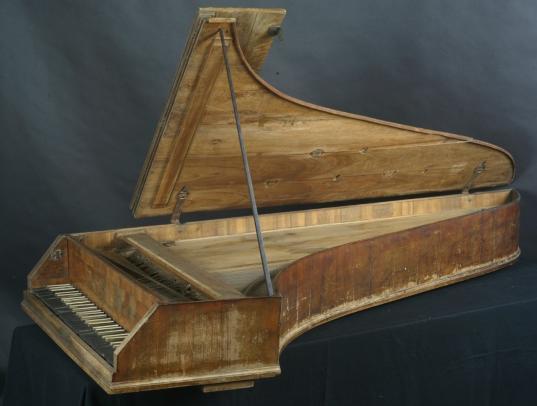
This grand in typical south German style of the time before 1774 can be seen as representative of the piano fashions in Mozart's youth. It stood in a former inn in Tannheim (district Reutte/Tyrol). In 2011 our institut was requested to a free investigation and documentation of this instrument of high historical and cultural value.which had suffered a few previous DIY repair attempts before.
During first investigations of the outward appearance a great similarity to a signed instrument of slightly smaller size and compass were apparent, acquired in 2009 by National Music Museum in Vermillion (SD, USA; NMM 13010). This was built by the Regensburg instrument maker Franz Jacob Späth (also: Spath) in 1767 and modified slightly after. While the Tannheim instrument was documented at our expense, further similarities as well as differences in construction could be verified and so the ascription to Franz Jacob Späth strengthened.
Even after the loss of the original signature its still visible shape (see below) on the wrest plank of the same shape and size as on the instruments in Vermillion or Oberammergau supports the ascription to Franz Jacob Späth before or including 1773/74, since Späth changed the manner of signing the instruments after his son in law joined the firm and changed its name to „Späth & Schmahl“ and signed thereon now on left front corner of the resonance board.
Mozart wrote to his father about Späth in 1777: „Ehe ich noch vom Stein seiner Arbeit
etwas gesehen habe waren mir die spättischen Clavier die Liebsten.“ (Before I saw some of Stein's work the Späthian keyboards were my favourites)
(Hintergründe zum "spättischen Clavier").
Franz Jacob Späth's grand pianos were an unknown entity until recently. With the Vermillion (ex Dingolfing) instrument and afterwards this second grand we now can estimate the characteristics and construction of these early grands.
His piano action resembles a maybe common simple action in principle based on Gottlieb Schröter's 1720 design. A peculiarity of both instruments and maybe typical for Späth is the internal barring with oblique links spreading the string tension and vibrations of the resonance board to the lower baseboard and the whole instrument frame. Johann Andreas Stein who worked one and a half years at Späth's workshop. later used the same sort of internal construction in some instruments (Berlin, Leipzig 171, München BNM).
Franz Jacob Späth's importance in keyboard making
Späth was a rather inventive piano maker with plenty of creative and refined constructions - and did not forget to make it public.
Already in 1751 he offered an instrument with 30 alterations, in 1770 his "Clavecin d'amour," probably the first version of his tangent piano (see below "without hammers or quills"!) and combinations of harpsichord and tangent piano, in 1779 a two-manual harpsichord and piano combined. In the following years exports to Vienna and Paris are documented. In an ad from 1783 an instrument resembling the Tannheim grand in compass and design was offered.
Although instruments by him are rare it appears that Späth together with Christian Ernst Friederici in Gera was one of the first wide range producers of grand pianos during the first phase of swing from harpsichord to piano. But Späth's assortment consisted of a multitude of different models and constructions with different mechanisms. Insofar Mozart's respect may also have referred to this widespread range of assortment. What kinds of instruments Mozart when and where may have encountered we can only assume but his familiarity might allow us to assume how common they might have been then.
(from: Musikalische Nachrichten und Anmerkungen, 18. Stück, Leipzig 1770. S. 142.)
Regensburg.
We were requested to publish the following from there: We wished, and so might the reader, that the author would have been a bit more specific.
As it deserves, to inform a kind public about a newly invented action without hammers or quills, the end signed produced with the so called Clavecin d'Amour this is done herewith, and in doing so we not only ascertain this already very popular instrument's internal perfection, worth and durability magnificently enriched but also an able player may achieve by the so different pressure part delicate and tender, part penetrating but silvery sounds the utmost pleasure and admiration, since this beautiful instrument in using one manual with 8 to 10 alterations excels all Clavecins and Pantaleons in regard of tender treatment the more pleasantly, as a minimum of care in tuning is required, therefore the player has control with much charm has the glory in command. The price is 30 to 40 ducats.
To bring the musical pleasure by enhanced variation into a higher degree of perfection the signed below produces these Clavecins d'Amour with two manuals (or keyboards) above each other where the lower the popular harpsichord, the upper the so called Clavecin d'Amour, besides a quite natural Flauto traversiere most delightfully is applied. Connaisseurs and those seeking delight in entertaining themselves quite alone will find their utmost satisfaction in this invention, the more as they have 50 of the most pleasing alternations at their disposal. The end signed below also hopes being applauded as the like has inspired him several times to consider greater perfection in his so popular as widely spread instruments and to gain popularity by constant quick service for a kind public.
Franz Jacob Spath.
citizen, organ and instrument maker
in Regensburg.

Explanation to this advertisement:
This ad for the "Clavecin d'amour" with "newly invented action without hammers or quills" is probably the first report about the existence of the tangent piano, and as such, of particular interest. The term"... d'amour/d'amore," then publicly known from Viola d'amore, Hautbois d'amour, Flauto d'amore, Clarinetto d'amore asf. still was expected to evoke positive expectations of remarkably sweet sound, interesting character and emotional impact and was expected to arise attention to the new instrument but apparently got forgotten faster than the instrument itself. A similar fate had the not identical „Cembal d'amour“ by Gottfried Silbermann, a clavichord with strings of double length struck in the center by the tangents (see below).
Remarkable is also his mention of his two-manual combination instruments, as mentioned above harpsichord plus tangent piano with or without additional flute rank he offered. Even in those days these combined instruments , though for sure rare and expensive, might have played an important part in spreading these new sound ideas.
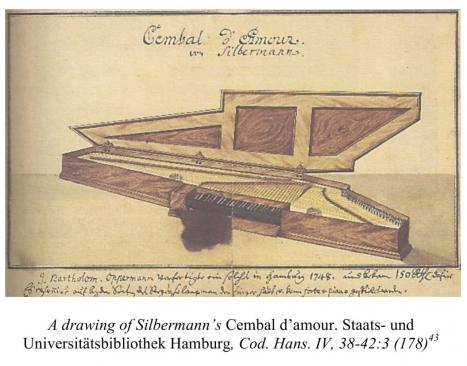
(aus: Kenneth Sparr: David Kellner - A biographical survey, S. 36)
The documentation of the Tannheim grand was the basis of plans for reconstruction, built by our "Arbeitsgruppe Spath" Magdalena Balk, Marlis Dörhöfer and Helmut Balk.
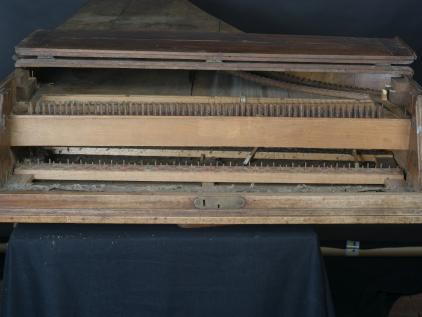
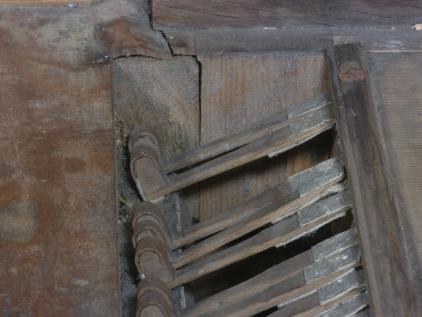
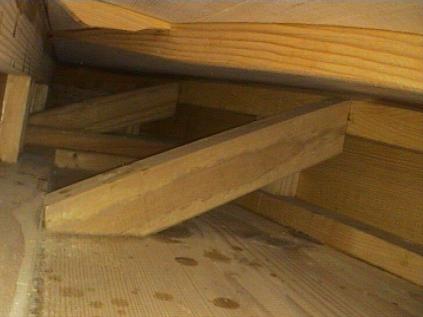
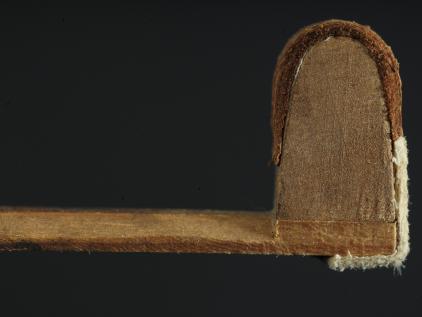

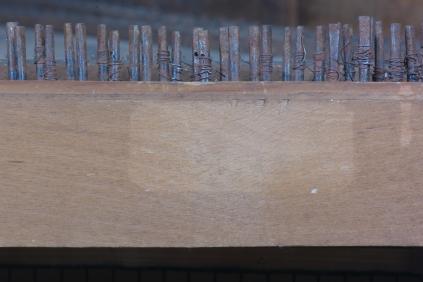
The usefulness of a careful documention can be seen here: A slight discolouration on the wrestplank reveals the position and placement of a lost label having been glued there which dimensions can still be measured and compared to other instruments where this sort of label is present. Since Späth changed his pattern of signing instruments when his son-in-law joined the firm in 1774 even this empty shape allows a estimation of date for the instrument.

With the other existing original instruments like the grand in Vermillion and the remodelled instrument in Oberammergau this signature note is still preserved.
Furthermore, since the instruments of the company were signed differently, namely on the left side of the resonator, after 1774, when his son-in-law Schmahl joined, the even the absent signature label indicates that this instrument should have been made earlier and must have been built and signed by Franz Jacob Späth only.




